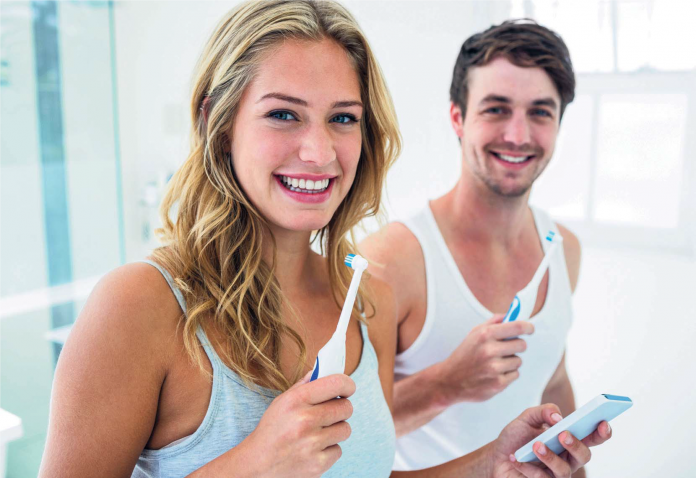
By Elaine Tilling MSc DMS RDH FAETC MIHPE, BSDHT Publications Committee, Education and Project Manager TePe Oral Hygiene Products Ltd
Dental decay and gum diseases are the most common diseases in man. Both are preventable.
Can teeth be for life?…. Yes! If you’re prepared to invest in a little time and effort to maintain them. Our teeth are designed for life.. but just like the rest of our body they need to be looked after if we want to keep them looking good and functioning well. In the same way, we maintain our cars by putting the correct fuel in and ensuring regular servicing, our teeth and gums require a similar level of care.
Gums that bleed are a sign of gum disease – this can be prevented and treated easily. Gum disease is a major cause of tooth loss in adults but, with effective home care and professional dental support, it can be slowed down to a rate that should allow you to keep most of your teeth for life.
Tooth pain is a sign of a problem, so seek the advice of a dentist at the first indication of discomfort. The earlier a problem is detected, the simpler and less costly it is to put right.
FUEL FOR A HEALTHY MOUTH
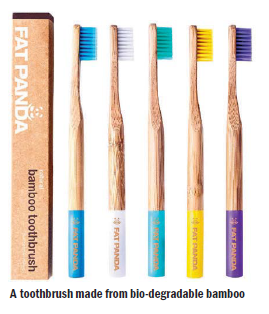 A healthy balanced diet is essential for all systems in our body to function properly. A balanced diet that confines products with a high sugar content to meal times is the key for healthy teeth. Every time the mouth is exposed to sugar it produces acids that attack the teeth. It can take your saliva up to 45mins to neutralise the acids. It is not the quantity of sugar that is the issue for teeth .. it is the frequency with which we consume it. Try to keep sugar containing foods and drinks to mealtimes.
A healthy balanced diet is essential for all systems in our body to function properly. A balanced diet that confines products with a high sugar content to meal times is the key for healthy teeth. Every time the mouth is exposed to sugar it produces acids that attack the teeth. It can take your saliva up to 45mins to neutralise the acids. It is not the quantity of sugar that is the issue for teeth .. it is the frequency with which we consume it. Try to keep sugar containing foods and drinks to mealtimes.
If you do need to snack then savoury foods are better for the teeth. If you do eat fruit as a snack, try to eat something alkaline such as cheese afterwards. The following are examples of foods that are ‘kind to teeth’.
- Cheese
- Raw vegetables
- Nuts
- Breadsticks
Keeping hydrated is also important for the mouth. Water, milk and sugar free drinks are all ‘safe’ for teeth. Drinks containing sugar should be confined to meal times and alcohol drunk in moderation.
HOME MAINTENANCE
Brushing for two minutes twice a day with a fluoride toothpaste and including cleaning between the teeth once a day is the basis for keeping your teeth for life. Both manual and electric toothbrushes when used correctly for two minutes are generally as effective as each other. One of the benefits of an electric toothbrush is that some versions can alert
you to overbrushing and most versions can time your cleaning. A dental minute and a real minute can differ! Having a way of monitoring your two minute session with a toothbrush ensures that you brush for the optimal time. There are also some pretty clever family apps associated with electronic toothbrushing that can work to motivate the family to brush regularly and for the appropriate time. Establishing healthy habits at an early age is really important, as the health of the baby teeth is critical to the health of the developing adult teeth. The journey for keeping your teeth for life really starts with the first tooth.
Unfortunately, a toothbrush can only reach 60% of the tooth surface, leaving the areas between your teeth untouched. Cleaning these areas with dental floss or interdental brushes – if the gaps are large enough – will ensure that you remove the plaque bacteria that forms on these surfaces. Most dental disease starts between the teeth and so cleaning these sites daily is a really important part of keeping your teeth and gums healthy.
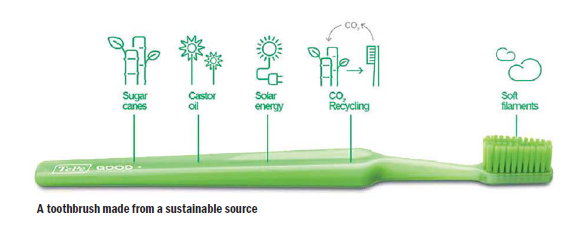
The Plastic Issue. If sustainability and concern for the planet is standing in your way to using what are predominantly plastic products did you know that you can recycle your toothbrushes? It’s a simple case of ‘off with their heads’! Take a pair of garden clippers and simply snip off the head/ brush end and put it in the kitchen waste and pop the handle in the plastic recycling bin. All toothbrush heads, including the new environmentally friendly ones, contain three components made from different materials which our waste systems currently cannot separate and so for now – these do have to go into our normal kitchen bin.
There are a growing availability of toothbrushes made from plants. From bamboo to sustainable plant based plastics – all of which can be recycled once the handles are separated from the heads. The handle can then be recycled in the plastic recycling, in the case of plant based plastics or in the food waste bins in the case of the bamboo brushes; all of these options have less impact on our planet than traditional materials.
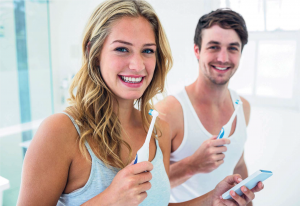
PROFESSIONAL SERVICING:
Make time for a dental check- up. Recommended intervals are every 6 months for children and between 3 months and 24 months for adults. Prevention is always preferable and far cheaper than cure. Many of the UK population qualify for free or subsidised dental care. check this out on the NHS Website.* Most practices offer treatment payment schemes and dental insurance policies. Details about these plans can be found on practice websites or explained in person at your local dental practice. Dentistry, unlike general medical practice is not fully funded within the NHS and has required an increasing individual personal contribution since 1951. Advances in technology, materials and treatment protocols for infection control in dental practice make dentistry relatively expensive to provide and so preventing disease in he first place makes good sense.
A Dental Hygienist is the member of the team that specialises in prevention of tooth decay and gum disease, and is trained specifically to treat and care for the soft tissues in and around your mouth. The dual qualified Dental Hygienist & Dental Therapist can also undertake routine fillings in adults and children and extractions of baby teeth. You can now go and see a Dental Hygienist or Dental Therapist without seeing your dentist first, which you might find easier if you are a little nervous. Many Dental Hygienists and Dental Therapists see patients under direct access arrangements now – ask at your local dental practice for details. Dental Hygienists and Dental Therapists are highly skilled and trained in dealing with nervous patients and can often allay your fears, paving the way for treatment by the dentist, if required.
THINGS TO AVOID AND WHY…
Smoking tobacco can cause many different medical problems. Most people are aware that smoking is bad for general health. However, the damage that smoking does to the teeth, gums and mouth is not as well-known. Smoking can lead to tooth staining, gum disease, tooth loss and in more severe cases mouth cancer.
Smoking can increase bacterial plaque formation, which may lead to gum disease. The blood supply is restricted in smokers which limits the healing capacity of the gums. As a consequence, gum disease will develop more quickly in smokers than in non-smokers.
Electronic cigarettes or vapes deliver nicotine without the cancer-causing chemicals that smoking tobacco produces. Using these devices can be an effective way of giving up smoking. However, whilst they are believed to be considerably less damaging they cannot be assumed to be completely harmless.
The current health concerns about e-cigarettes are connected with the flavourings. From a dental perspective, the flavours can be sticky, sweet and acidic – all of which have the potential to damage the tooth surfaces. Giving up smoking is the single most beneficial thing you can do for your oral and general health and whilst using vapes to achieve this goal works for many, the end goal for all users is to stop the dependency on either habit.
TEETH FOR LIFE?
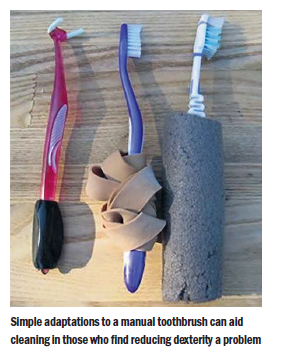 Technology is already supporting oral home care in the form of electronic toothbrushes which, if used correctly, can make toothbrushing simpler and interactive. Dexterity can deteriorate with age and so electronic toothbrushes can help those who struggle to brush manually, because the cleaning motion is undertaken by the brush head. Developments in technology will no doubt continue to support individuals with developments in early diagnosis of disease for example. So, the future is bright for teeth and gums!
Technology is already supporting oral home care in the form of electronic toothbrushes which, if used correctly, can make toothbrushing simpler and interactive. Dexterity can deteriorate with age and so electronic toothbrushes can help those who struggle to brush manually, because the cleaning motion is undertaken by the brush head. Developments in technology will no doubt continue to support individuals with developments in early diagnosis of disease for example. So, the future is bright for teeth and gums!
If electric toothbrushes are not for you, then a range of simple adaptations to a manual toothbrush can aid cleaning for those who find 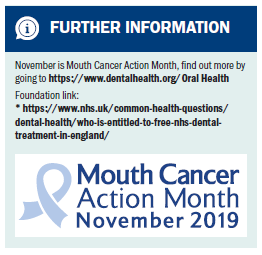 reducing dexterity a problem. Ask your dental care team for some advice.
reducing dexterity a problem. Ask your dental care team for some advice.
Eating a healthy balanced diet and timespent on your daily oral hygiene routine coupled with regular MOT’s at your dental practice, makes keeping your natural teeth into old age more than just a possibility. The investment of your time and attention will help you keep your teeth for life.
More information is available at dentalhealth.org






